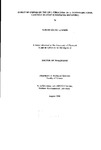EFFECT OF COPPER ON THE GILL STRUCTURE OF A EURYHALINE CRAB, CARCINUS MAENAS (CRUSTACEA:DECAPODA)
| dc.contributor.author | LAWSON, SARAH LOUISE | |
| dc.contributor.other | School of Biological and Marine Sciences | en_US |
| dc.date.accessioned | 2013-11-14T11:59:29Z | |
| dc.date.available | 2013-11-14T11:59:29Z | |
| dc.date.issued | 1994 | |
| dc.identifier | NOT AVAILABLE | en_US |
| dc.identifier.uri | http://hdl.handle.net/10026.1/2708 | |
| dc.description.abstract |
A posterior gill of the common shore crab Carcinus maenas (Crustacea:Decapoda) was used to study the effects of sublethal copper concentrations on gill morphometry, and gill cell ultrastructure and distribution. Primarily, the ultrastructure and distribution of gill cells in the untreated gill of crabs acclimated to 35‰ seawater were characterised. Gill ultrastructure was subsequently shown to vary markedly at 10‰ compared to 35‰ seawater. Ultrastructural and distributional, rather than gross morphological, change occurred in the gill following exposure to copper at each salinity. Ultrastructural studies showed that as the length of copper exposure increased the gill epithelial layer became highly vacuolated, the number of plasma membrane infoldings and mitochondria became reduced, the microtubular network became disrupted, the endoplasmic reticulum became swollen and the cell cytoplasm contained many free ribosomes. Copper exposure also resulted in an increase in the number of haemocytes in the gill, some of which became attached to the basal epithelial cell surface or actually infiltrated into the epithelial cell cytoplasm. Ultrastructural change was more extensive when copper was administered at 35‰ rather than 10‰ seawater. These effects are described and correlated with previously documented biochemical and physiological responses to heavy metals in crustaceans. In addition, the elemental composition of the gill granular haemocytes suggested they play an important role in the immobilisation and removal of copper-from the gill. This study has shown the way forward in creating a better understanding of the mechanisms behind heavy metal toxicity in marine organisms is the use of environmentally realistic concentrations of heavy metal administered in flow-through seawater systems. | en_US |
| dc.description.sponsorship | ZENECA Limited, Brixham Environmental Laboratory | en_US |
| dc.language.iso | en | en_US |
| dc.publisher | University of Plymouth | en_US |
| dc.title | EFFECT OF COPPER ON THE GILL STRUCTURE OF A EURYHALINE CRAB, CARCINUS MAENAS (CRUSTACEA:DECAPODA) | en_US |
| dc.type | Thesis | |
| plymouth.version | Full version | en_US |
| dc.identifier.doi | http://dx.doi.org/10.24382/4260 | |
| dc.identifier.doi | http://dx.doi.org/10.24382/4260 |
Files in this item
This item appears in the following Collection(s)
-
01 Research Theses Main Collection
Research Theses Main


